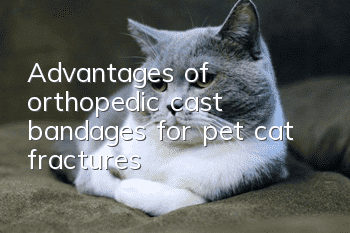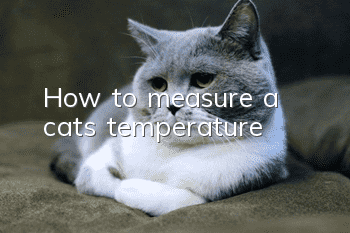Advantages of orthopedic cast bandages for pet cat fractures

Nowadays, most domestic pet cats live in high-rise buildings with dozens of floors. They live in seclusion and have reduced activities. Although it is comfortable to stay at home every day, not all cats can endure loneliness. Some cats can’t help but want to jump on the window sill. Look at nature. Due to the owner's negligence, the cat may fall down the stairs if the window is not closed tightly. Although cats have a strong ability to survive jumping off the building, it is still a very dangerous thing. Cats falling from high places Basically there will be fractures.
Recently, a pet hospital in Fuzhou received a cat that had fallen and suffered multiple bleeding and fractures. After an hour of rescue, the cat successfully completed the bone-setting operation. According to the cat owner, Mr. Wang, who is from Fu'an, his cat accidentally fell from the fourth floor. Although a cat's balance ability is very strong, when it falls, it will lose its balance if it encounters an obstacle. We know that fractures require bone repair, and after bone repair, they need to be fixed. We usually use plaster for fixation. However, plaster is not very hygienic and inconvenient for cats. At this time, you might as well try orthopedic casting bandages.
1. Composition of orthopedic cast bandages
A polymer polyurethane product made of highly elastic fiberglass cloth impregnated with polymer polyurethane. Animal experiments and acute and chronic toxicology experiments have confirmed that medical polyurethane is non-toxic, non-teratogenic, and has no local irritation reaction.
2. Advantages of orthopedic cast bandages
Small animal orthopedic bandages are high-tech products that have good X-linearity, fast hardening, high strength, light weight, good ventilation, are not afraid of secondary water immersion, and are comfortable, safe, hygienic, and beautiful for animals.
1. High hardness and light weight: Polyurethane materials are composed of soft segments and hard segments, and the soft segments increase the cohesion and hardness. It has been tested that the hardness of the cured bandage is 20 times that of traditional plaster. This feature ensures reliable and firm fixation after correct reduction. It uses less materials and is light in weight, equivalent to 1/5 of the weight of plaster and 1/3 of the thickness, which can reduce the load on the affected area and reduce the load on functional exercises after fixation, which is beneficial to blood circulation and promotes healing. Secondly, after the plaster is solidified, it still has a certain degree of brittleness. Therefore, if the load is too large, it can cause fracture and lead to redisplacement after the fracture is integrated. The polyurethane material of the orthopedic cast bandage launched by China Pet Doctor Network is composed of soft segments and hard segments. This feature effectively reduces the possibility of re-injury to the affected area due to external forces, thereby effectively ensuring the fixation effect.
2. Porous and good breathability: Orthopedic cast bandage uses high-quality raw yarn and unique mesh weaving technology, which has good breathability, is conducive to skin ventilation, and solves the problem caused by local tube bandaging. Skin problems such as hot flashes and itching.
3. Fast hardening: The hardening process of orthopedic cast bandages is fast and starts 3 to 5 minutes after opening the package.After hardening, it can bear weight in 20 minutes, while the plaster needs about 24 hours to completely harden and bear weight.
4. Excellent X-ray transmittance: The orthopedic cast bandage has excellent radiolucency, and the X-ray effect is clear, which helps the doctor to understand the healing status of the affected limb at any time during the treatment process. The transmittance of plaster is relatively poor, and sometimes the healing situation can only be clearly understood after the fixation is removed. This avoids the trouble of having to rebandage a second time when it is found through X-ray examination that the healing standard has not been reached after the plaster is removed.
5. Good waterproofing: After the orthopedic cast bandage is hardened, the surface is smooth, and the water absorption rate is 85% lower than bandages and splints made of gypsum and ordinary glass fiber. Even after the animal comes into contact with the water environment, it will It can effectively ensure that the affected area is dry.
6. Easy to operate, flexible, and good in plasticity: Orthopedic casting bandages only need to be squeezed 2 to 3 times in normal temperature water before use. If the fixed area has skin trauma or the operation takes a long time, it can be fixed directly without soaking in water first. After fixing, water can be sprayed on the outer layer to speed up the hardening. It has good plasticity, high bending and tensile strength, can be bent at will, and the bandage can be made into a tube shape or a support.
3. Effect of temperature on adjusting curing time
By adjusting the water temperature, the hardening time can be appropriately adjusted. When the water temperature is increased, the hardening speed will be accelerated and the hardening time will be shortened; when the water temperature is lowered, the hardening time will be appropriately extended.
4. Advantages of the product in treatment
For doctors, better flexibility is convenient for local shaping and bandaging. For patients, the shrinkage is small after drying, and the uncomfortable symptoms of skin tightness and itching after the plaster dries will not occur.
In addition, after fixing the wound, you need to inject or take anti-inflammatory drugs regularly to avoid the symptoms of cat fever (details) and wound infection and inflammation. You can go to the pharmacy to buy 0.5g of cephalosporin and lidocaine hydrochloride injection (or sterile water for injection, lidocaine injection will be less painful, and sterile water will be more painful), mix it thoroughly and take half the dose for subcutaneous injection into the cat ( Lift the cat's neck skin and inject at the back of the cat's neck, being careful not to pierce the cat's flesh). The effect of injections will be better than that of taking medicine. It is best to inject anti-inflammatory injections once a day.
- Cataract symptoms and treatments in cats
- How many months old should a kitten be dewormed?
- What medicine should American curl-eared cats take for colds?
- What is the reason why Siamese cats have unformed stools in summer? Many novices don’t know!
- Why does cat fart smell so bad?
- Why does a cat stick out its tongue?
- What should you pay attention to when leaving your cat alone at home?
- What color are cats’ eyes? Cats’ eyes have different colors.
- What are the personality characteristics of the Turkish Van Cat?
- What should I do if my Siamese cat keeps meowing? An introduction to how to stop Siamese cats from meowing



